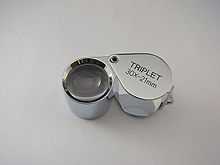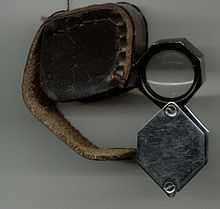Loupe

A loupe (/ˈluːp/ LOOP) is a simple, small magnification device used to see small details more closely. Unlike a magnifying glass, a loupe does not have an attached handle, and its focusing lens(es) are contained in an opaque cylinder or cone or fold into an enclosing housing that protects the lenses when not in use. Loupes are also called hand lenses.
Optics

Three basic types of loupes exist.
- Simple lenses, which result in the highest degree of Optical aberration and are generally lower magnification.
- Multiple lenses, generally higher magnification because of the reduced Optical aberration.
- Prismatic, Multiple lenses with prisms used to change the Perspective.
Uses
Loupes are used in a number of industries, notably the jewelry trade, watchmaking, photography, printing, dentistry, education and ophthalmology. Loupes are also used in academia and life sciences, such as geology and biology. Amateur naturalists may also find a hand lens or a loupe a useful tool when looking at or identifying species.
Jewelers

Jewelers typically use a monocular, handheld loupe in order to magnify gemstones and other jewelry that they wish to inspect.[1] A 10x magnification is good to use for inspecting jewelry and hallmarks[1] and is the Gemological Institute of America's standard for grading diamond clarity.[2] The stone will sometimes be inspected at higher magnifications,[citation needed] although inclusions and blemishes must be visible at 10x to affect the grade.[2]
Watchmaking
Loupes are employed to assist watchmakers in assembling mechanical watches. Many aspects require the use of the loupe, in particular the assembly of the watch mechanism itself, the assembly and details of the watch dial, as well as the formation of the watch strap and installation of precious stones onto the watch face. Some families like Kruder which were into watchmaking and working with glass started producing high-quality loupes in addition to their watches[citation needed]
Photography
Analog (film) photographers use loupes to review, edit or analyze negatives and slides on a light table. Photographers using large format cameras also use a loupe to view the ground glass image to aid in focusing. DSLR camera users also use loupes to help to identify dust and other particles on the sensor, in preparation for sensor cleaning.[citation needed]
Printing

Offset and flexographic printing see frequent use of loupes in order to carefully analyze how ink lies on paper. Strippers use loupes in order to register film separations to one another. Pressmen use them to check registration of colors, estimate dot-gain, and diagnose issues with roller pressure and chemistry based on the shape of individual dots and rosettes.[citation needed]
Dentistry
Many dentists use loupes to better scrutinize things in their patients' mouths in order to make a better diagnosis, for example, to determine how far a crack proceeds along the surface of a tooth. Loupes are also used in order to perform on a more precise level; while dentists drill teeth on a millimetre scale, magnification can enlarge the dentists' view of the teeth, perhaps making it easier to inspect teeth for decay or see things that ordinarily would not be seen without magnification.[3][4]
Specialties of dentistry, such oral surgery and periodontics, may benefit from the use of loupes as well. The oral cavity is notorious for being a place containing small entities with limited access.[3][5] Magnification can be very helpful when suturing a flap.

Because dentists use both of their hands while performing dental procedures, dental loupes are binocular and usually take on the form of a pair of glasses. Some dental loupes are flip-types, which take the form of two small cylinders, one in front of each lens of the glasses. Other types are inset within the lens of the glasses. A typical magnification for use in dentistry is 2.5x, but dental loupes can be anywhere in the range from 2x to 8x.[citation needed]
Together with proper access to the oral cavity, light is an important part of performing precision dentistry. Because a dentist's head often eclipses the overhead dental lamp, loupes may be fitted with a light source. Loupe-mounted lights used to be fed by fiber optic cables that connected to either a wall-mounted or table-top light source. Newer models feature a more convenient LED lamp within the loupe-mounted light and an electric cord coming from either the conventional wall-mounted or table-top light source or a belt clip rechargeable battery pack. Options for loupe-mounted cameras and video recorders are also available.[6]
Surgery
Surgeons in many specialties commonly use loupes when doing surgery on delicate structures. The loupes used by surgeons are mounted in the lenses of glasses and are custom made for the individual surgeon, taking into account their corrected vision, interpupillary distance and desired focal distance. Multiple magnification powers are available. They are most commonly used in Neurosurgery, plastic surgery, cardiac surgery, orthopedic surgery, microvascular surgery, and tendon repair surgery.[citation needed]
Geology

The loupe (hand lens) is a vital geological field tool used to identify small mineral crystals and structures in rocks. It is also an essential tool in mining for finding gold nuggets.[citation needed]
Biology
Loupes are used by professional and amateur field biologists for help identifying species in field situations where a full-sized microscope is impractical, but the ability to observe small morphological characteristics is desired. Many floras and diagnostic keys for identifying plant or animal species recommend the use of a loupe, because taxa may be separated by minute details like the presence of hairs, shapes of hairs and glands.[citation needed]
Meteoritics
Scientists in the meteoritics and planetary science field as well as private collectors of meteorites use loupes as one of their primary tools in meteorite classification and study, and also for simple examination in the field during meteorite recovery.[citation needed]
Electronics
Due to the extremely small size of many modern surface-mount components used in compact electronics, engineers often use a loupe to inspect the completed circuit board for manufacturing defects such as solder bridging and missing or misaligned components. While soldering or reworking surface-mount components by hand, a loupe is sometimes essential for identifying and aligning parts. Due to the ever-decreasing size of electronic components, the need for magnification is increasingly becoming a factor in circuit-building.[citation needed]
Tattooing
Tattoo artists use loupes to inspect the quality of their needle tips. They do this to ensure the least amount of damage possible to the skin surface.[citation needed]
Numismatists and coin collectors
Loupes are an essential tool in both numismatics, the study of currency, and the related practice of coin collection. Coin collectors frequently employ loupes for better evaluation of the quality of their coins, since identifying surface wear is vital when attempting to classify the grade of a coin. Uncirculated coins (coins without wear) can command a substantial premium over coins with slight wear. This wear cannot always be seen with the naked eye. Numismatists can also employ loupes to identify some counterfeit coins that would pass a naked-eye visual inspection.[citation needed]
Philatelists and stamp collectors
Stamp collectors employ loupes to improve their ability to evaluate the quality of their stamps. Identifying surface, adhesive, and perforation is vital when attempting to classify the grade of a stamp. Mint stamps (stamps without cancellations) with no wear can command a substantial premium over mint stamps with slight wear. This wear cannot always be seen with the naked eye. Practitioners of philately, the study of postage and revenue stamps, also employ loupes to identify counterfeit stamps that would pass naked-eye inspections.[citation needed]
Sharpening
Sharpeners of knives or other edged or pointed tools may use a loupe to inspect the tool and ensure correct angle, straightness of the bevel, a sharp edge and/or point, and a polished finish.
See also
References
- ↑ 1.0 1.1 "Jewelry - How to Use a Loupe - Using Jewelry Magnifiers". Jewelry.About.com
- ↑ 2.0 2.1 "Essential Four Cs: Clarity". Gemological Institute of America.
- ↑ 3.0 3.1 Taschieri, S; Del Fabbro, M; Weinstein, T; Rosen, E; Tsesis, I (2010). "Magnification in modern endodontic practice". Refu'at ha-peh veha-shinayim 27 (3): 18–22, 61. PMID 21485416.
- ↑ Maggio, MP; Villegas, H; Blatz, MB (2011). "The effect of magnification loupes on the performance of preclinical dental students". Quintessence international 42 (1): 45–55. PMID 21206933.
- ↑ Stanbury, Spencer J.; Elfar, John (2011). "The Use of Surgical Loupes in Microsurgery". The Journal of Hand Surgery 36 (1): 154–6. doi:10.1016/j.jhsa.2010.09.016. PMID 21074952.
- ↑ "Futudent HD Camera".
| Look up loupe in Wiktionary, the free dictionary. |
| Wikimedia Commons has media related to Loupes. |